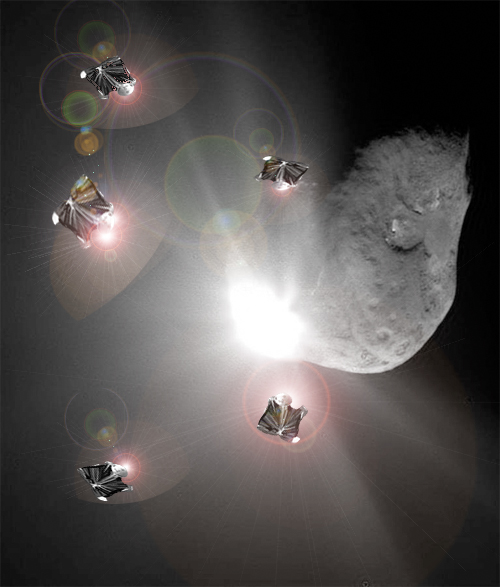If you’ve got some ideas about how to deflect an asteroid or comet heading towards Earth, there’s an opportunity out there to have your concept reviewed by some of the world’s top astronomers and physicists. The only restriction is that you must be a student or a young professional under the age of 33. This announcement comes on the heels of notices of other opportunities for young people to get involved with space missions. The space sector must be listening to recent complaints that the younger generation feels a disconnect to space-related activities. At any rate, these are great opportunities.
Here’s more on the asteroid competition, as well as more ways for students to get involved with space missions:
The “Move An Asteroid 2008†competition is sponsored by the Space Generation Advisory Council. It’s an international technical paper competition looking for unique and innovative concepts for how to deflect an asteroid or comet that may impact the Earth. The competition is open to individuals or teams, and they must write and submit a 3-10 page original technical paper on their innovative concept. The 1st place award is a trip to present the winning paper at this year’s Space Generation Congress (SGC) and International Astronautical Congress (IAC) which take place in Glasgow, Scotland from late September until early October 2008. The 2nd place award is a trip to present at the SGC. Entries are due on June 9, 2008 and winners will be announced on June 30, 2008, the 100th anniversary of the Tunguska Event, the largest asteroid/comet impact event in Earth’s recent history.
Another opportunity is the Cassini Scientist for a Day contest. The contest is open to all students in the U.S. between grades 5 and 12, working alone or in groups of up to four students. This is a competition for the privilege of deciding where to point the cameras onboard the Cassini spacecraft on June 10, 2008. There will be 55 minutes of time where the winners will control of spacecraft, plenty of time to turn it as needed and point the cameras at pretty much any target you’d like. In case you’re not sure what targets would be best, the Cassini team has narrowed the field of possible targets. Deadline for submission is Noon, Pacific Daylight Time on May 8, 2008 (3:00 p.m. Eastern time).
Next, there’s the NASA Quest LIMA Challenge for Students in Grades 4-8. In this challenge, students become scientists and propose Antarctic research. The Landsat Image Mosaic of Antarctica is the first true-color high-resolution satellite view of the Antarctic continent. Using this view of Antarctica, students must develop a research question and debate the value of studying the chosen feature. Registration is currently open and educational resources are available online. This is going on right now, with the deadline for preliminary proposals due on April 20, 2008, so check this one out soon.
Also, there’s a chance for U.S. students to involved working with the mission operations associated with the Mars Reconnaissance Orbiter and specificially the CRISM (Compact Reconnaissance Imaging Spectrometer for Mars) on board MRO, currently orbiting Mars. The project is called Mars Exploration Student Data Teams. This is an ongoing program for high school students, and one adult facilitator is required. This program is facilitated through a cooperative effort by NASA and Arizona State University. Another similar program is the Mars Student Imaging Project that works with the Mars Odyssey orbiter. You can find more info on that program here.
Also ongoing is the ISS EarthKAM (Earth Knowledge Acquired by Middle school students)program, a NASA education program which gives students teachers the chance to choose targets on Earth for pictures to be taken from the International Space Station. Learn more about that program here.
Original News Source: Space Generation Advisory Council


Is there a reason why 33 is the cutoff age and not some other age?